
Croquet - Quick Guide
Croquet - Overview
Croquet is a classic way of spending boring summer afternoons. It is an interesting way of grooming both physical and mental skills at the same time. It is an interesting and fun game to enjoy in the backyard. The backyard dimension to support this game is 35x28 yards. This game is played in soft mount and flat grass.
People can simultaneously enjoy with friends while playing this game. For this game, six cast-iron hoops are required to be set strongly on the ground along with a peg. The design always remains the same. Croquet is played with four balls each weighing one pound with diameter 1/32 less than the inside width of the hoop.
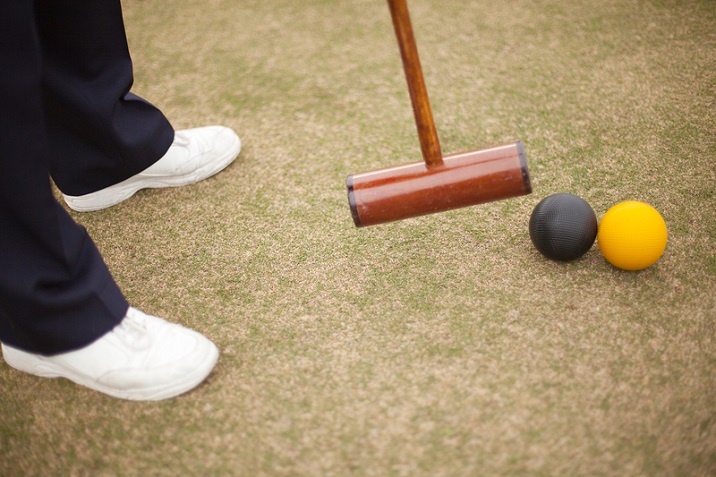
Croquet is considered to be a household game in the UK. It can be played in numerous ways. While people enjoy Croquet as a social garden game, it is also played at the international level with championships authorized by the World Croquet Federation. Mostly, we see two forms of Croquet, they are Garden Croquet and Golf Croquet. We will be discussing about these in the coming chapters.
As there are two forms of Croquet, the objectives of both the forms are bit different. In Golf Croquet, every player aims to get the ball in each hoop first. For every turn, the player is allowed one stroke. While in Garden Croquet, numerous strokes are allowed to achieve different goals. Unlike Golf Croquet, the players balls have to pass every hoop and hit the peg to win the game.
History
The origin of Croquet is very doubtful. It is believed that this sport was introduced by Ireland and England in 1830s. Croquet gained popularity and became a pass time for the upper classes in the later part of the 19th century and the early 20th century. It was played by both the genders, male and female, with the same interest. However, after the introduction of lawn tennis, the popularity of croquet started declining.
It is believed that Croquet is behind the origin of Snooker. There was a decline in Croquet in between 1920-1960s. After which there was an increase in free time especially for retired people and the market was again flushed with Croquet sets making it a worldwide interest.
It is believed that Croquet is behind the origin of Snooker. There was a decline in Croquet in between 1920-1960s. After which there was an increase in free time especially for retired people and the market was again flushed with Croquet sets making it a worldwide interest.
Participating Countries
Croquet is a highly sociable sport. Presently, only 10 countries own full membership for this sport. In every country, Croquet clubs are affiliated to a National Croquet Association, which monitors the administration of the game, attends marketing problems, publishes newsletters and mostly takes care of developing clubs financially. International membership for Croquet is given by the World Croquet Federation to a country.
Croquet - Playing Environment
Croquet is played by two sides with black and blue balls on one side and red and yellow balls on the other side. The main objective here is to advance the balls around the court by hitting them with a mallet.
A player or team scores a point for each hoop made in the correct order and direction. The team scoring six hoop points along with finishing by scoring one peg point for each of its balls is the winning team. Thus, the side scoring 14 points is the winner.
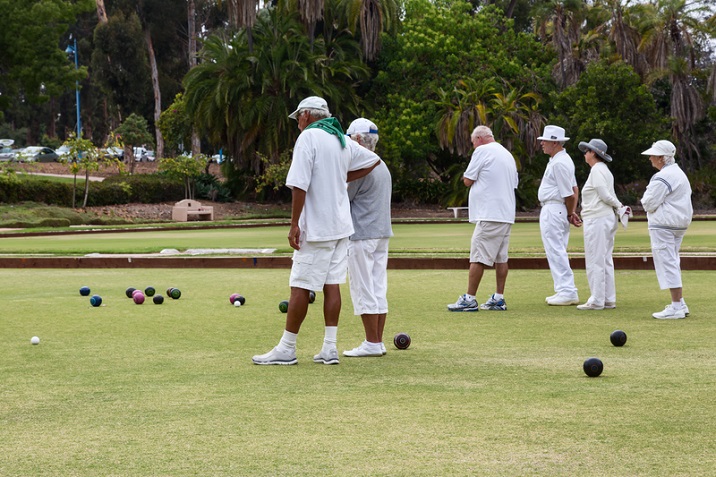
Each side has either one player for the singles game or two players for the doubles. Rules for both singles and doubles remain the same. Each player takes turns and the game continues by one player at a time. The player who starts the game is the striker, who has one shot and the shot ends after one turn unless the player has earned an extra shot. Eventually, the turn ends when the player has no extra shot in the account. The game continues with the player in the opponent side using their turns.
The Lawn Setting
The peg is placed in the middle of the court where the game is to be played. Four hoops are placed at equal distance from the peg in a rectangular form measuring 10.5m x 7m. The remaining two hoops are placed on the longer central line in such a way that it bisects the rectangle by 3.5m from the peg. Make sure that all the hoops are placed parallel to the shorter side of the rectangle. Generally, the boundary of the court is stated by the flags used at each corner. These flags should be of dimension 17.5 x 14m. There are different flag variations for different court dimensions.
Croquet - Equipment
Mallets
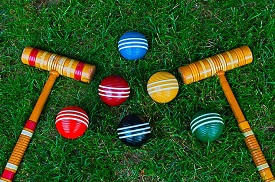
Mallets are one of the most important and expensive equipment for playing Croquet. The weight of mallets depends on the budget for the set. A low budget set includes lightweight mallets weighing around 2lbs or less. They are made of ordinary hardwood with a round broomstick handle. They dont last long.
An expensive set includes better hardwood like ash. They make shots easier and feel nicer to play with. They are heavy and their handles are round but have an octagonal cross-section. The heads are protected by brass band or hard plastic end face.
Hoops
A low budget Croquet set consists of hoops made of thin wire with short legs. In a garden Croquet set, the hoops are straight wire legs with no carrot. Thick wire ensures better performance. In tournaments, heavier hoops with carrots on each leg are used as they help to hold the ground more strongly.
Balls

The very next thing that comes in mind after mallets are balls and their weights. For young children a set of balls weighing 12 ounce is recommended. While using lightweight mallets, heavy balls of 16oz should be picked. Balls are selected according to the mallets.
Some other equipments include a wooden box or a bag, some set of clips and corner flags.
How to Play Croquet?
This chapter provides a step-by-step method that will help the beginners play the game with the right approach and right style. Following are the steps that should be followed sequentially.
The beginning
The game starts by tossing a coin to see which team gets a chance to make the choice. The team that wins the toss decides if they want to play first or second. The other team selects the pair of balls they want red/yellow or blue/black. The game begins from a point which is at a meter in, from the boundary in front of the first hoop.
The side which starts the game hits any of their balls into the court. After their turn, the other side hits their ball from the starting point. Immediately after, you are allowed to gain extra shots if any.
The first four turns
In the first four turns, the players have to make sure that all the balls are played. For example, if the red ball is played first then the other team has to choose whether to play the black or blue ball. If the black ball is selected, then the third is the turn of yellow and fourth is the turn of the blue ball.
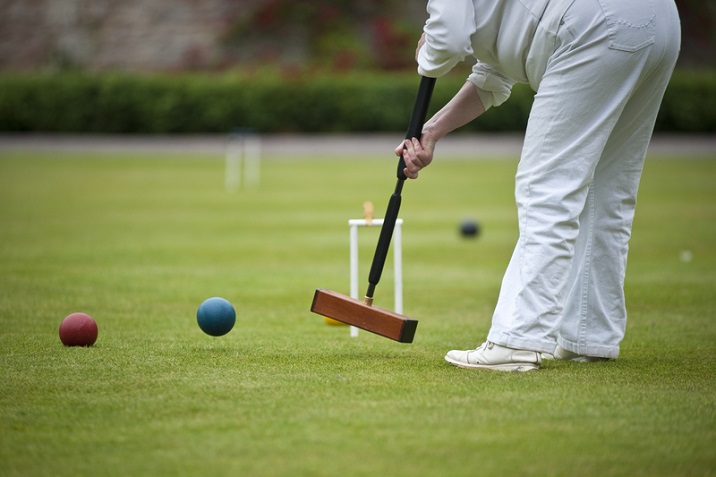
After the first four turns
After the four turns are completed, the team that has started the game again has to choose the ball. Here the first team has chosen the red/yellow option so they have to choose between them and start the next round of shots. A team can hit only a single shot but if it has earned extra shots then it has to continue its turn.
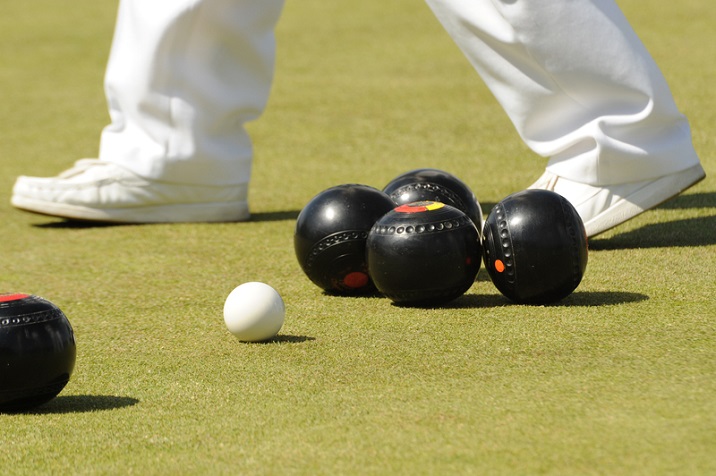
After two extra shots are earned
If a team has to earn an extra shot, then the player has to hit the ball in such a way that it touches one of the three balls. Of the two extra shots, the first shot must be played in such a way that the striker ball has to come in contact with the ball that has been hit. The second extra shot has to be played from the place where the striker ball lies. The team can again earn extra shots after earning a hoop.
Ball off the lawn
If a ball goes out of the lawn it is replaced at a place one meter away from the place from where it has gone out. The play continues and there is no penalty on the team. After the completion of the shot, if a ball lies within one meter of the boundary, it is placed one meter away from the boundary.
Scoring a Hoop Point
A hoop point can be scored easily when a ball passes far enough from the hoop such that all the remaining balls have crossed the wire of the hoop on the side playing the game.
Striking the Ball with the Mallet
The ball should be shot with any end face of the mallet and with no other part. The ball played needs to be struck cleanly. The hoops and the peg that enable the players to play a shot cannot be moved. The players are not allowed to put the foot on the ball.
Finishing and Winning the Game
The side that earns six hoop points for each ball and then strikes the peg with both balls is declared as the winning side. Generally, this process takes place in the same turn when a croquet stroke and the continuation stroke are shot. It is ideal that the player takes the croquet from the team mates ball near the peg. The balls should be aligned so that the croquet stroke hits the partners ball with the peg, followed by an extra shot where the strikers ball hits the peg.
Anyhow, the game can be easily won by striking a peg with each ball in two different chances. For example, in one chance Player A strikes red and it hits the peg. In the very next turn, the yellow ball needs to be shot to hit the peg. The only chance of winning is when a player accomplishes these shots prior to the players on the opponent side with both the balls. The ball that earns six hoops and hits the peg to earn peg points is immediately removed from the ground.
Some More Versions
However apart from Garden Croquet there are two other versions of Croquet. One is Golf Croquet that is played by six hoop setting. There are no extra shots and it is a very simple form of Croquet. The second version is Wickets Croquet commonly referred to as the Nine Hoops Croquet. This game is played by nine hoops and pegs. The hoops are in a double diamond formation. This Croquet is very famous in North America and many South European countries.
Croquet - Rules
The official rules of Garden Croquet are laid by the World Croquet Foundation. They permit some different variations and also include some tough challenges and make the game a bit more interesting and complex so that Croquet is seen as a serious game instead of some socializing time pass game.

Following are a list of rules to be kept in mind while playing Garden Croquet.
The game starts by flipping a coin. The side which wins the toss decides which side is going to start the game and the other side decides the balls to be used.
Each player gets one chance to hit the ball unless an extra shot is earned. Extra shot can be earned either by running a hoop or by hitting any of the other three balls.
In the first four turns, the players have to bring all four balls into play, after which they have a choice to play any ball they wish to.
The extra shots are not collective. Also only one extra shot can be earned from every ball till the next hoop is earned.
There is no penalty if a ball goes out of the court.
All the balls being played need to be passed through at least some part of the hoop.
The players have to hit the ball with the face of the mallet without moving the other balls, hoops, or peg to make the shot.
At the end of the game when a ball hits the peg, it is removed from play.
Though the rules of Garden Croquet seem complicated and too much to memorize, the game is easy to pick and these rules can be taken care of with no time as this game is great fun to play.
Croquet - Championships & Champions
As we know Croquet is considered as a socializing game, but serious Croquet is seen in championships held by the World Croquet Federation. The two major championships held are −
Inter Country Championships
The English National Golf Croquet Championship
The National Inter-Club championships include six championships. They are −
The Inter-Club Championship (Association Croquet)
The Golf Croquet Inter-Club Championship (Golf Croquet)
The Mary Rose Inter-Club Trophy (Association Croquet)
The Golf Croquet Inter-Club Shield (The Murphy Shield) (Golf Croquet)
The Longman Club Team Cup (Association Croquet)
The Secretary's Shield (Association Croquet)
Champions
Robert Fulford
Robert Fulford is a Croquet player from England who was born in Colchester and started playing croquet at the age of 15 at his local school. He often travelled to the cheap hotels or homes of local croquet players but could not earn much. In 1990, he won World Championship for the Hurlingham Club in England.
Two years later, he won a World Championship in the US. In 1994, he again won the World Championship held in Carden Park in England. Next World Championship win came to him in 1997 for Moorabinda Croquet Club. The last World Championship that he won was held in 2002 in Wellington in New Zealand.
Chris Clarke
Chris Clarke is a croquet player who previously represented England but now represents New Zealand. Clarke started playing Croquet at the age of 13. In 1995, he won a World Championship in Association Croquet. In 2008 also, he won the World Championship in which he attained the position of World Number One player.
In 2008, he also reached the semi-finals of WCF Golf Croquet World Championships and the finals of the 2009 European Championships. He could not play Croquet due to back injury but he came back in 2012 and won ten matches in order to improve his world rankings. Due to some controversy, he switched to New Zealand and was the member of 2014 winner team MacRobertson Shield team.
Reginald Bamford
Reginald Bamford is a croquet player from South Africa. He won Association Croquet World Cup four times. Besides this, he also took part in many other championships. He participated in Open Championships and won ten times.
He also participated in Mens Championships and won it six times. Currently, he is a businessman and a qualified chartered accountant. He is also the World Champion in Croquet Golf.
Ben Rothman
Ben Rothman is a croquet player from North America. He started his career in 2007 and in 2009 and 2010, he was the player number one in US Croquet Association. In 2009, he reached the finals of WCF World Championships but was defeated by Reg Bamford. He took part in many other competitions and won them.
In 2008, he took part in North American Open Championships and won it. In 2009, he took part in three championships which include National Singles and Doubles Championships, Selection Eights Championships, and Open Championships. In 2010, he won three championship titles.
Miranda Chapman
Miranda Chapman is a croquet player from New Zealand who represented Victoria in Interstate Cup. In 2012, she represented Australia in World Championships.
In 2009, she was the winner of Australian Doubles Titles whereas in 2010, she was the winner of Australian Womens Title. She now works as a Prosthetist where she makes artificial limbs for the people whose limbs are amputated.